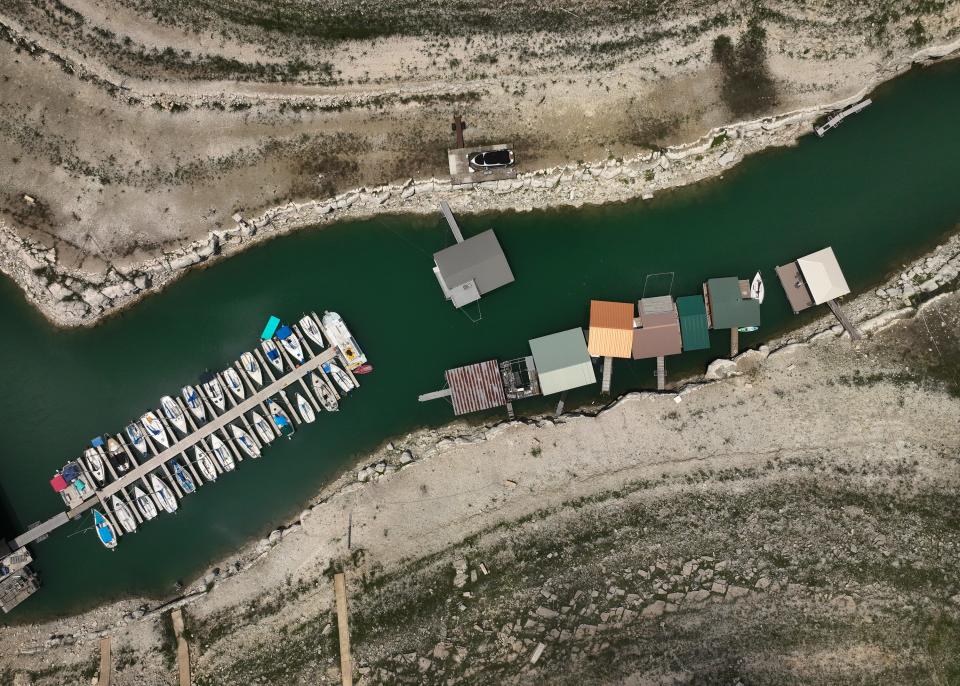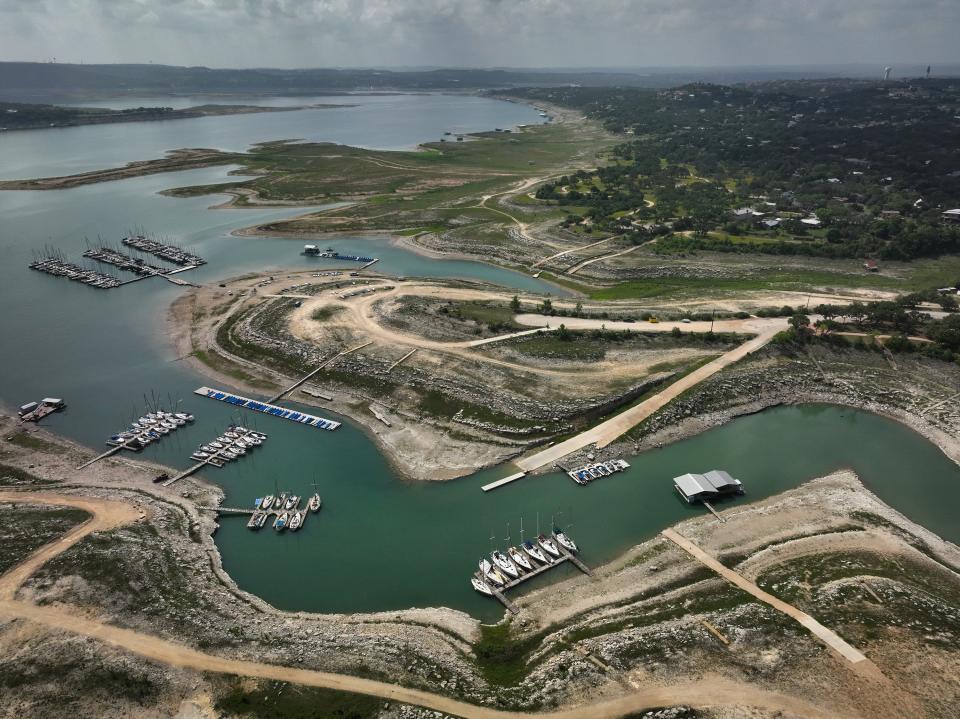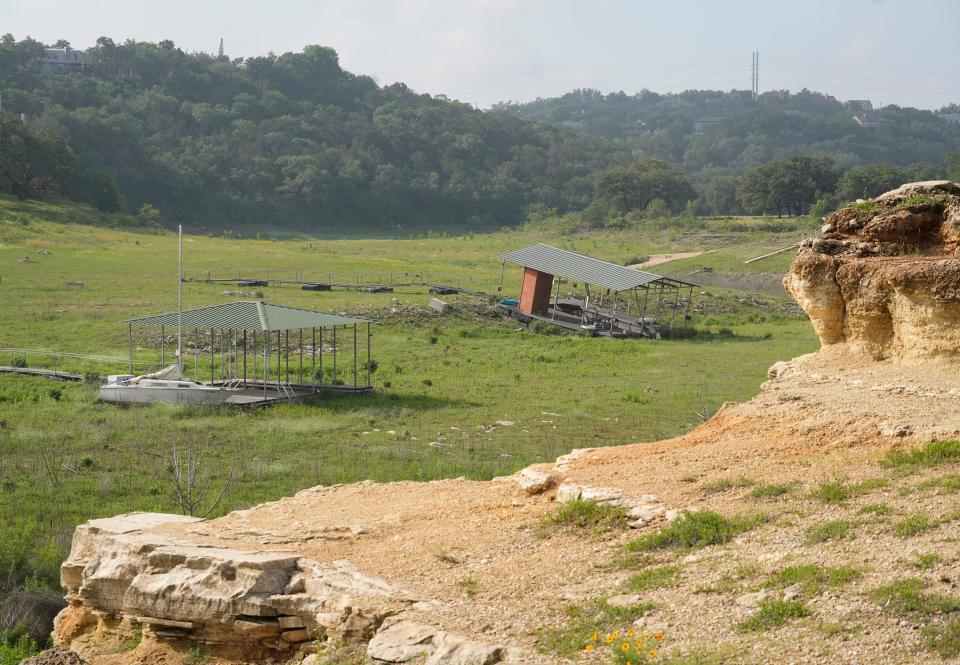Austin's water supply is squeezed by extreme drought. Here's what you can do | Grumet
If you’re nowhere near the receding lakes, it’s easy to get fooled by a good downpour, such as the one that drenched parts of Austin on Sunday with up to an inch of rain.
But even as yards perk up for a little bit, the situation remains dire in the Highland Lakes, which provide the drinking water for Austin and neighboring communities. Central Texas remains gripped by a drought that’s on track to become one of the worst we’ve seen.
The reservoirs at Lakes Travis and Buchanan are a combined 42% full.
Lake Travis alone is only 38% full.
“I'll have friends in the Austin area that will say, ‘Oh, wow, we got an inch of rainfall at my house last weekend, I guess the drought’s over,’” said John Hofmann, executive vice president of water for the Lower Colorado River Authority.
Not even close, he tells them. Not as long as Lake Travis remains this low.
“It's an historic drought. It's one of the most significant droughts we've seen,” Hofmann told me. “We are at a point now where discretionary water use is a big deal.”

How you can help
As the Austin area continues to experience an historic drought, residents can take some common-sense precautions to reduce water use:
If you have automated sprinklers: Make sure they're set for the right watering day and time. In Austin, watering with automated sprinklers is allowed before 5 a.m. or after 7 p.m. on Wednesdays for odd-numbered addresses and on Thursdays for even-numbered addresses. Hose-end sprinklers can be used at Austin homes before 10 a.m. or after 7 p.m. on Saturdays for odd-numbered addresses and on Sundays for even-numbered addresses.
Speaking of sprinklers: Take a look next time they're running to see if any sprinkler heads need to be adjusted to direct the water toward the yard, not the sidewalk.
If you're picking out plants to add to your yard: Make sure they're suited for this climate and can survive on water only once a week.
If you have a swimming pool: Make sure it's covered when not in use. In the hottest parts of summer, an uncovered pool can lose up to an inch of water through evaporation every few days.
For information on watering restrictions in Austin, visit austintexas.gov/department/find-your-watering-day.
How bad is the central Texas drought?
Central Texas has always been a land of unforgiving extremes. Downpours and droughts. Even when we get a nice rain in Austin, it doesn't do much for the water supply feeding our taps.
“You need rainfall to happen in Fredericksburg, and Llano, and Menard, and Brady and all the way up to Brownwood,” Hofmann said. “That big bowl that feeds into the Highland Lakes, that's where the rainfall counts. That's where you need it, and we haven't had that up there.”
The drought is so severe that, for the second year in a row, LCRA has cut off water from the Highland Lakes for the rice farms and other agricultural operations downstream in Colorado, Wharton and Matagorda counties. There just isn’t enough water for them.
Indeed, this drought is reaching for a place in the record books.
Our region’s drought of record, which ran from 2008 to 2015, included the second- and third-worst years in LCRA history in terms of the lowest amounts of water flowing into the system.
The worst year? That came during our current drought, in 2022. The following year, 2023, was the fourth-worst year.

Meanwhile, more residents and more industry put a greater demand on Austin’s water supply. (Tesla's Gigafactory Texas, which opened in April 2022, is now Austin Water’s fifth-largest customer.)
And long-term, a distressing new report predicts a significant increase in 100-degree days and intensifying droughts as Texas feels the impact of climate change.
The report — produced by the Texas state climatologist at Texas A&M University, John Nielsen-Gammon, in collaboration with the nonpartisan advocacy group Texas 2036 — says 100-degree days will be nearly four times as common in 2036 as they were in the 1970s and 1980s.
More intense heat will mean even more water in the lakes lost to evaporation — a 7% increase in “summertime evaporative losses” by 2036, the report predicts — which will only compound the effects of future droughts.
Perhaps you’re thinking: Is there any good news here?
Well, we’ve made it to May — and May and June are typically our region’s largest rainfall months. Let’s hope that holds true and that the skies send us some relief.

Beyond that, we’ve got to make our own luck. Considering many of us already have water-efficient appliances and good household water habits (you don’t run the water while brushing your teeth, right?), the biggest place we can make a dent is with outdoor water use.
Austin Water typically sees a 50% to 60% increase in daily water use during the summer months, when lawn sprinklers are going, compared with a month like January.
Ensuring you’re complying with the once-a-week lawn-watering rules and picking water-wise plants makes a huge difference when multiplied across the roughly 250,000 households served by Austin Water.
On Thursday, the Austin City Council is expected to adopt an updated Water Conservation Plan and Drought Contingency Plan, outlining goals for reducing water use over the next decade. The proposed drought plan includes LCRA’s revised drought stages, which have been retooled to define the conditions when more stringent watering restrictions are needed and what the restrictions at each level would be.
Expect to hear more of those details if May and June don’t bring a rainy reprieve, or if another scorching summer further depletes the Highland Lakes. Weather patterns and drought conditions might be out of our control, but everyone can still do their part within their yards to treat water like the precious resource it is.
Grumet is the Statesman’s Metro columnist. Her column, ATX in Context, contains her opinions. Share yours via email at bgrumet@statesman.com or on X at @bgrumet. Find her previous work at statesman.com/opinion/columns.
This article originally appeared on Austin American-Statesman: Conservation needed as drought tightens grip on Austin's water supply

